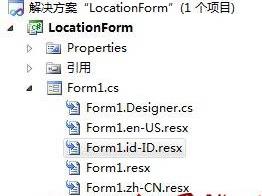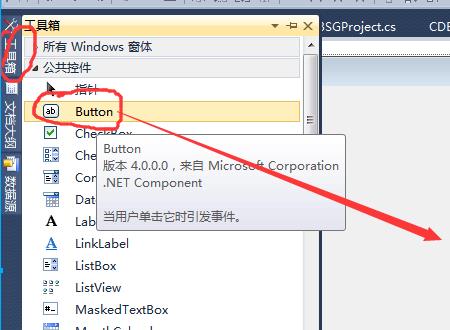C#如何通过一个按钮实现窗体界面的中英文切换?
Posted
tags:
篇首语:本文由小常识网(cha138.com)小编为大家整理,主要介绍了C#如何通过一个按钮实现窗体界面的中英文切换?相关的知识,希望对你有一定的参考价值。
C#可以通过最基础简单的代码实现语言切换,新建一个工程,然后在视图的工具箱工具中,添加控件,通过按钮点击,实现中英文的切换。具体的方法如下:
1.新建工程:工程都是从初始窗体上一点点搭建的,本例为新建空白默认工程;

2.新建后无法往窗体上添加控件,这是由于工具箱没有打开,提供以下两种操作:快捷键:Ctrl + W,X (即为持续按住Ctrl键后,依次按W键和X键);打开菜单栏的“视窗-工具箱”均可唤醒工具箱。取消工具箱显示,直接点击工具箱右上角“关闭”;

3.添加控件:此处用按钮、标签、窗体显示文字切换。通过点击按钮,切换中英文字。

4.添加代码:(个人选择,将待切换文字独立写入一个类,便于移植管理;也可在同一个类中写入文字定义),需定义一个语言标志,用于区分显示语言;按键点击事件中,切换语言标志,切换语言显示;

5.显示效果:运行后,点击按钮,窗体、标签、按钮均切换中英语言。

一、窗体的国际化解决方案
新建一个WinForm解决方案后,选择主窗体,右击查看属性,找到Localizable属性,将其置为True,然后找到Language属性,选择你需要切换的语言,比如英语(美国)、中文(简体,中国)等。此时根据实际情况设计该Language下的窗体样式及语言。
图1 Form的属性设置

图2 根据选择的语言,自动生成的资源文件

二、使用CultureInfo类实现国际化解决方案
CultureInfo 类包含区域性特定的信息,例如语言、国家/地区、日历以及区域性约定。
using System;
using System.Collections.Generic;
using System.Linq;
using System.Windows.Forms;
namespace LocationForm
static class Program
/// <summary>
/// 应用程序的主入口点。
/// </summary>
[STAThread]
static void Main()
Application.EnableVisualStyles();
Application.SetCompatibleTextRenderingDefault(false);
//System.Threading.Thread.CurrentThread.CurrentUICulture = new System.Globalization.CultureInfo("en-US");
System.Threading.Thread.CurrentThread.CurrentUICulture = new System.Globalization.CultureInfo("zh-CN");
Application.Run(new Form1());
三:实现效果


官方参考文献:http://msdn.microsoft.com/zh-cn/library/h6270d0z.aspx
另外您可能是需要动态切换语言的吧.
接着往下看.
在 Visual Studio 的设计视图中,如果在 Properties 窗口中改变了程序的默认界面语言(Language),我们会注意到无论是工程还是窗体对应的 .Designer.cs 文件都会有显著的改变。比如,我们创建一个叫 MyForm 的 form,并且添加一个叫 MyButton 的按钮。
在改变窗体 Properties 中的 Language 属性之前, .Designer.cs 代码文件中的 InitializeComponent 方法的内容大致如下:
private void InitializeComponent()
this.myButton = new System.Windows.Forms.Button();
this.SuspendLayout();
//
// myButton
//
this.myButton.Location = new System.Drawing.Point(100, 200);
this.myButton.Name = "myButton";
this.myButton.Size = new System.Drawing.Size(75, 23);
this.myButton.TabIndex = 0;
this.myButton.Text = "My Button";
this.myButton.UseVisualStyleBackColor = true;
//
// myForm
//
this.ClientSize = new System.Drawing.Size(292, 273);
this.Controls.Add(this.myButton);
this.Name = "MyForm";
this.Text = "My Form";
this.ResumeLayout(false);
而在改变了窗体 Properties 中的 Language 属性之后,工程中除了默认的 .resx 文件之外,还会自动添加一个 .zh-CHS.resx 文件(假设我们将 Language 改变为 Chinese (Simplified))。另外,.Designer.cs 文件中的 InitializeComponent 方法也会改变成:
private void InitializeComponent()
System.ComponentModel.ComponentResourceManager resources
= new System.ComponentModel.ComponentResourceManager(typeof(MyForm));
this.myButton = new System.Windows.Forms.Button();
this.SuspendLayout();
//
// myButton
//
this.myButton.AccessibleDescription = null;
this.myButton.AccessibleName = null;
resources.ApplyResources(this.myButton, "myButton");
this.myButton.BackgroundImage = null;
this.myButton.Font = null;
this.myButton.Name = "myButton";
this.myButton.UseVisualStyleBackColor = true;
//
// myForm
//
this.AccessibleDescription = null;
this.AccessibleName = null;
resources.ApplyResources(this, "$this");
this.AutoScaleMode = System.Windows.Forms.AutoScaleMode.Font;
this.BackgroundImage = null;
this.Controls.Add(this.myButton);
this.Font = null;
this.Icon = null;
this.Name = "myForm";
this.ResumeLayout(false);
我们注意到改变 Language 属性之后,代码的主要变化有:
ComponentResourceManager resources = new ComponentResourceManager(typeof(MyForm));
resources.ApplyResources(this.myButton, "myButton");
resources.ApplyResources(this, "$this");
另外,设置控件属性(比如显示文字 Text,控件大小 Size,显示位置 Location 等)的代码都没有了。也就是说设置控件属性的代码都是由 resources.ApplyResource 方法来完成的。那么在我们想改变 WinForm 程序的界面显示语言的时候,能不能直接调用 ApplyResources 方法呢?答案是肯定的。
为 myButton 添加 Click 事件的事件处理函数:
private void myButton_Click(object sender, EventArgs e)
int currentLcid = Thread.CurrentThread.CurrentUICulture.LCID;
currentLcid = (currentLcid == 2052) ? 1033 : 2052;
// Changes the CurrentUICulture property before changing the resources that are loaded for the win-form.
Thread.CurrentThread.CurrentUICulture = new CultureInfo(currentLcid);
// Reapplies resources.
ComponentResourceManager resources = new ComponentResourceManager(typeof(MyForm));
resources.ApplyResources(myButton, "myButton");
resources.ApplyResources(this, "$this");
参考技术B 重置所有显示控件的text属性 中文改为英文显示 貌似没有什么简单的方法 国际化其实也是内置多种语言 再切换的 参考技术C 把语言写成动态的放在数据库里面,供切换调用。 参考技术D 建议你关注一下Form.Localizable / Form.Language这两个属性的用法。c#如何单击按钮显示另一个窗体
在vs2010中,我想单击form1中的一个button,弹出form2,form2是我设计的另一个页面
怎么操作?如果不能实现,有没有类似能弹出另一页面的方法?
工具/材料:以Microsoft Visual Studio 2010为例。
1、首先点击“Microsoft Visual Studio 2010”图标,打开软件。

2、然后在该界面中,右键点击右侧项目,选择“添加”选项。

3、之后在该界面中,点击“Windows窗体”选项,创建新窗体。

4、接着在该界面中,点击左侧“工具箱”里的“Button”选项,拖到界面里。

5、之后在该界面中,双击“button1”控件。

6、最后在该界面中,写入“Form5 fm = new Form5();fm.ShowDialog();”代码即可。

Form2 f = new Form2();
f.Show(); 本回答被提问者采纳 参考技术B form frm2=new form2();
frm2.show();
我没开程序,大概是这个意思 参考技术C 代码:
protected void ButtonAddNewUser_Click(object sender, EventArgs e)
//在这里加入事件,然后去点击btnDel_Click的时候就会弹出
if (Page.IsPostBack)
btnDel.Attributes.Add("onclick", "return confirm('确定删除?')");
protected void btnDel_Click(object sender, EventArgs e)
//这个事件可以不存在,但是当按下这个按钮的时候就要弹出一个对话框窗口
//所以,我们可以把上面那段事件放于
//放于这个事件中
protected void Page_Load(object sender, EventArgs e)
//在这里加入事件,然后去点击btnDel_Click的时候就会弹出
if (Page.IsPostBack)
btnDel.Attributes.Add("onclick", "return confirm('确定删除?')");
以上是关于C#如何通过一个按钮实现窗体界面的中英文切换?的主要内容,如果未能解决你的问题,请参考以下文章